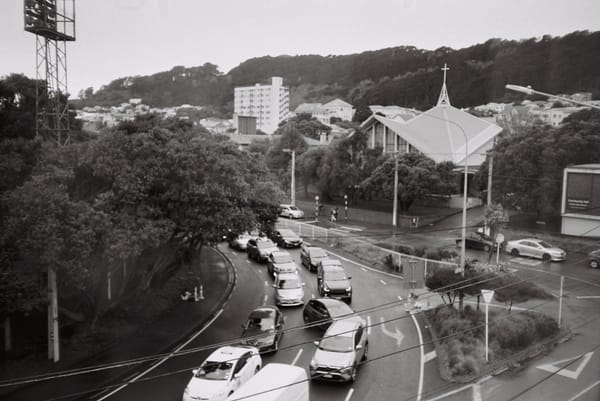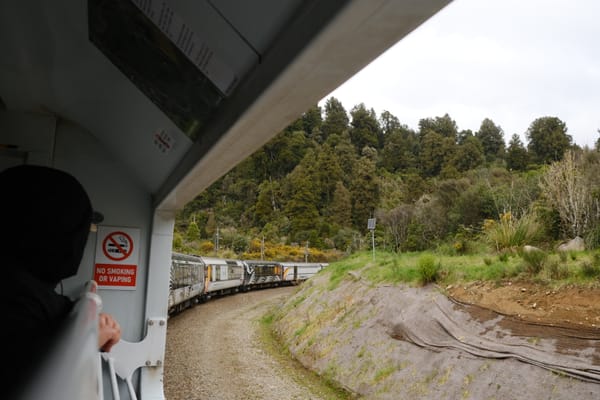The story behind the Government's rail funding announcement
Or, how we can start getting past the hangover of the 1990s.

Or, how we can get through the hangover of the 1990s.
A confidential meeting was held at the Greater Wellington Regional Council in June last year. Our elected leaders were shown a rail report, which I obtained a few months ago (Thank you LGOIMA).
The (catchily named) "Wellington Metro Rail Update on service impacts" detailed the real danger our train network faced.
A third of Kāpiti peak trains would be cancelled, indefinitely. Half of all Melling line trains. Half of all Johnsonville trains. All on the chopping block.
Why? Because our train tracks need serious work, according to everyone from KiwiRail to Greater Wellington Regional Council.
Thomas Nash, who leads transport at the Regional Council, describes it like this:
Restrictions stem from the government's rail assets being way, way overdue for renewals. It's like leaving potholes on State Highways for years and telling drivers to slow down driving past them. Maintain your assets!
When these "potholes" appear on a train network, KiwiRail enforces slower speeds to keep the trains safe and reduce damage to the lines. A dozen of these speed restrictions exist in Wellington alone, which are already causing delays.
KiwiRail gets a drop in the ocean in funding compared to highways, so repairing the lines is often delayed. Speed restrictions have lasted years and will last for years longer without intervention.
While slowing down trains in theory keep the rail lines lasting longer, journeys take longer and scheduled trains have to get cancelled.
Also, this trick doesn't last forever. Eventually, your pothole-ridden network needs money or risks closing down.
If that happened, Wellington's transport system would be fundamentally broken. It would take at least 100 extra buses each day to carry commuters into the central city from across the region.
These buses would be stuck in the endless traffic caused by drivers who used to rely on rail. The average car in New Zealand carries 1.5 people, so imagine what ten thousand more people driving every morning would do to congestion. Drivers would be shafted alongside train travellers.
Without a train network, congestion becomes almost unsolvable. Adding more lanes to our highways would increase rather than decrease congestion (which is a story for another time).
On top of that, losing our train travel means losing our most effective way to cut pollution from transport. If the trains stopped, pollution would go up. Lots.
A broken train network in Wellington is, frankly, a non-starter. Drivers, train travellers, regional residents, and central city dwellers would all be worse off.
Something needed to be done, otherwise train services would be hobbled indefinitely and train travellers may never come back. Train travel has already declined by 8% in the last year.
Daran Ponter, the chair of the Regional Council, saw the risk to services as so serious that he wrote to Simeon Brown outlining what was at stake.
The worst-case scenario in the Council’s analysis has not happened. Seeing the risk of disaster can spur action to avoid it. KiwiRail received some emergency funding last year which was deployed strategically to keep things running (relatively) smoothly.
Plus, our local leaders have been advocating for more money to fix the network. Thankfully, government listened (a bit).
Last week, the Ministers of Rail and Transport announced new funding to keep repairing the rail system.
Train commuters and businesses moving goods around the country will see more reliable rail services, thanks to the Government's investment of $604.6 million for rail upgrades and renewals through Budget 2025, Rail Minister Winston Peters and Transport Minister Chris Bishop say.
About $140 million over two years has been dedicated to fixing up Auckland and Wellington's passenger train tracks.
This is substantially less than what was asked for, but it's a start.
KiwiRail estimated it needed about $90 million each year for a decade to repair just Wellington's network. For context, that's 10 days of the Government's yearly pension budget to fund 10 years of rail repairs.
We're living through a hangover caused by decades of neglect by politicians and shareholders. It's taking far longer than it should to fix the problem. At least this announcement shows there's some recognition that investing in trains is an absolute no-brainer for New Zealand.
We're not out of the woods yet, but there are green shoots.

We can get through this rail hangover
Last year, Wellington received money to increase power capacity for new electric trains to Palmerston North.
This was approved under Simeon Brown. It wasn't something I expected from someone who loves promising tens of billions for economically unfeasible highways.
Chris Bishop and Winston Peters have recently taken over responsibility for rail.
These two Ministers seem to understand that rail is worth keeping around.
For Peters, railways are amazing for moving goods efficiently and cheaply. For Bishop, train networks are exactly what we need to lower the cost of housing.
Train stations unlock affordable apartment development for tens of thousands of people. This kind of housing can be built without needing to fit in a bazillion cars too. It's no mistake that Bishop was quoted saying:
"For many families, the dream of home ownership looks a little different today. Many young families are now choosing to swap the station wagon for the train station, and the corner dairy for the cafe."
If you look for them, we can see signs of a recovering rail system. The City Rail Link in Auckland, the new inland rail port in the South Island, logging exports travelling by train from Whanganui.
We can go far further. The government could run affordable train travel across Aotearoa so our regions aren't price gouged by Air New Zealand. KiwiRail could upgrade the tracks so Wellington's trains depart every six minutes. Politicians could fund a tram network through the central city to the hospital and the airport.
Rail recovery is not guaranteed. There's still questions about who funds train repairs. The Beehive wants councils to pay more, and councils want the Beehive to pay more. I'd lean towards the Beehive coughing up more money: they own the tracks, they should maintain them.
We're at the start of a very long track to a reborn rail system. This funding will keep our rail system alive just long enough for politicians to restore its glory.
It may take another government to reach the ambition I want for our nation. At the very least, our railways will have some potholes filled. It is long overdue.





